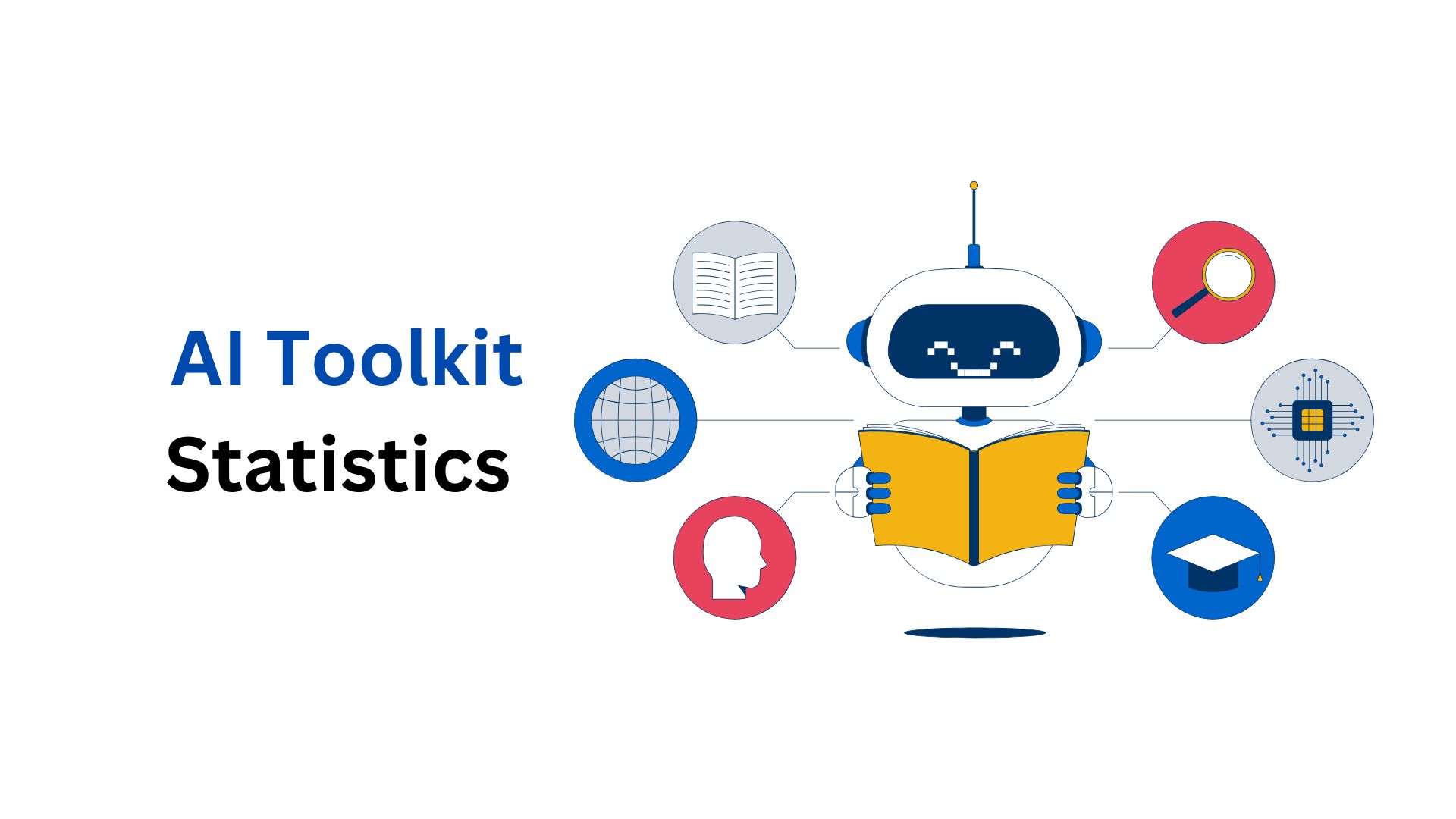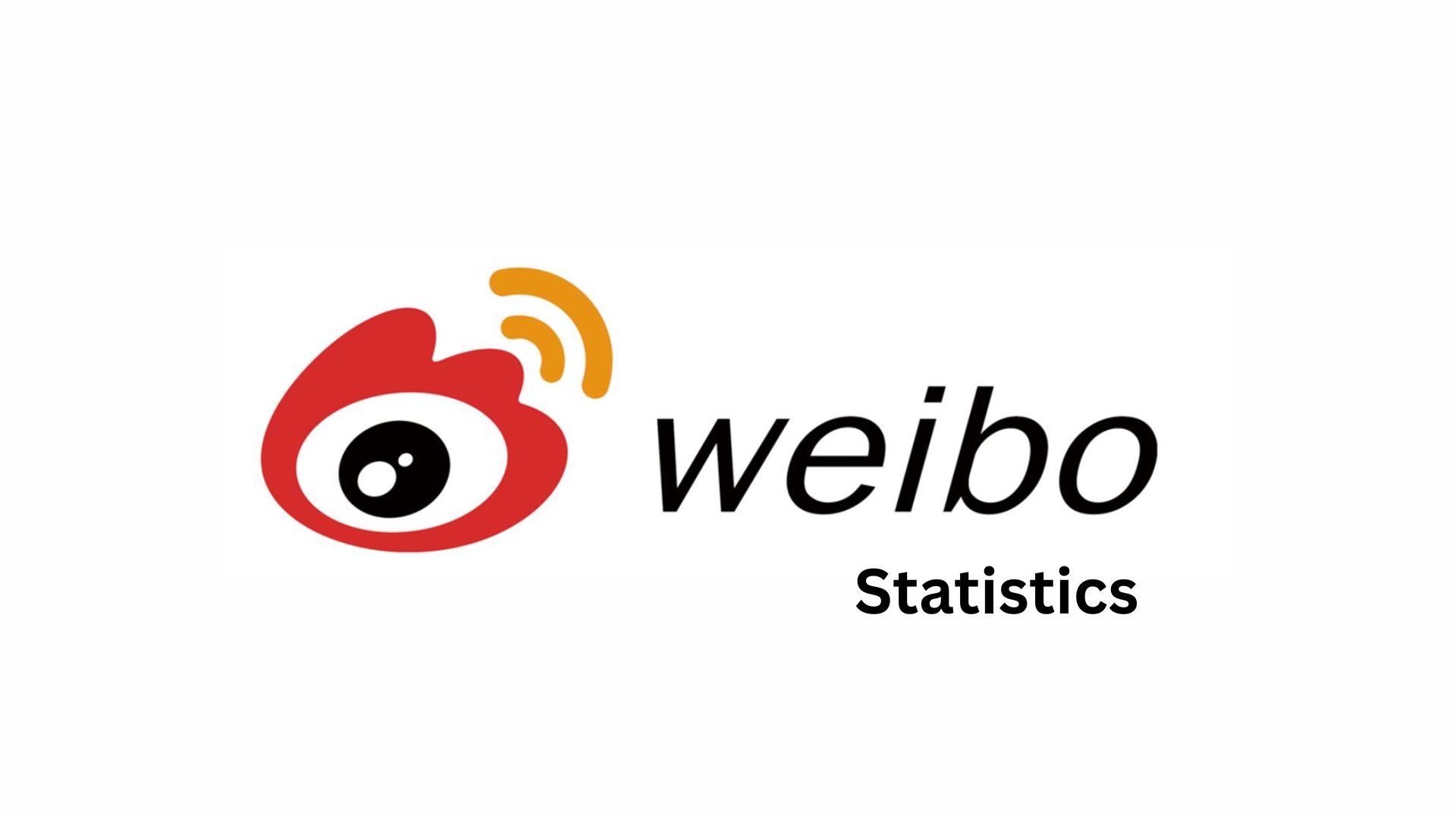Payroll Statistics By Employee Retention, Automation And Facts (2025)
Updated · Jul 02, 2025
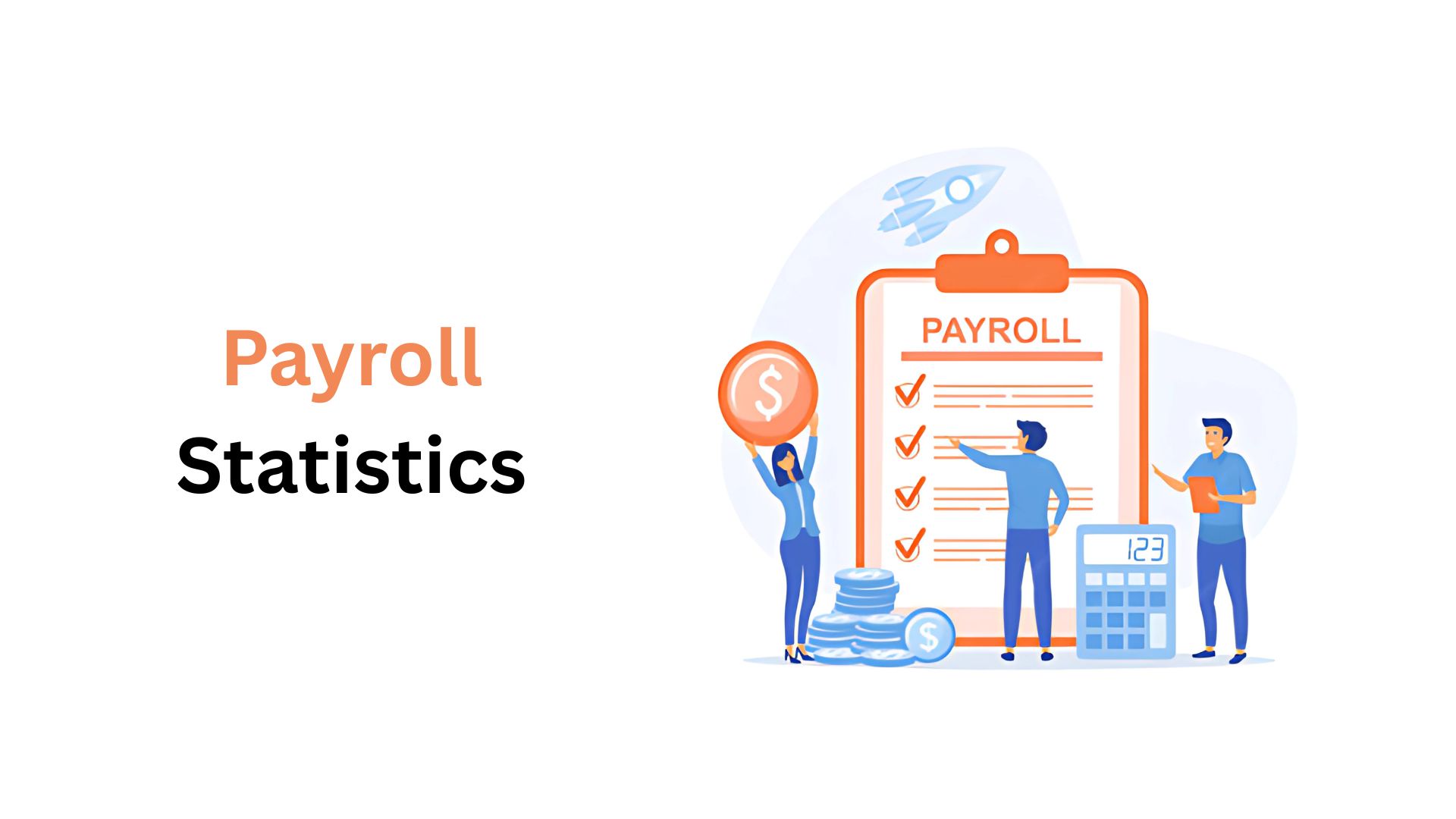
Table of Contents
- Introduction
- Editor’s Choice
- U.S. Monthly Change In Payroll Employment
- Number Of Employees Paid
- Payroll Frequency Statistics
- U.S. Monthly Change In Payroll Employment 2024, By Industry
- Payroll Records Stored
- Payroll Error Statistics
- Payroll Outsourcing
- Payroll Automation Statistics
- Payroll Employee Retention Statistics
- Conclusion
Introduction
Payroll Statistics: Payroll management is an important facet affecting business operations, employee satisfaction, compliance, and financial planning. In the year 2024, several trends began appearing, reshaping the way organisations look at payroll.
In 2024, payroll emerged as a critical business function, with nearly 70 percent of companies reporting issues in their payroll data, and over 82 million American workers experiencing paycheck errors at some point. About 65 percent of employees relied on each paycheck to cover basic expenses, and 95.15 percent were paid via direct deposit. In the private sector, 43 percent of establishments adopted a biweekly pay cycle, making it the most common rhythm, followed by 27 percent on weekly pay, 19.8 percent semi‑monthly, and 10.3 percent monthly. Payroll inaccuracies carried a tangible cost: a 1.2 percent error rate across a payroll of 100 employees earning $900 weekly could cost $56,647 annually.
Small businesses typically devoted more than six hours each month to payroll tasks, with one-third reporting that payroll consumed over 35 percent of HR effort. Cloud and automation adoption reached approximately 74 percent, yet 85 percent of organizations still encountered challenges with their payroll technologies. Additionally, around 53 percent of companies were penalized for non‑compliance within five years.
This article shall talk about some up-to-date Payroll statistics and latest insights so as to offer a full overview of the current scenario of payroll.
Editor’s Choice
- October 2024 saw payroll jobs rise gently in the U.S. by around 12,000.
- A good number of 57,000 jobs were created, meanwhile, in private education and health services in October 2024.
- About 48% businesses pay 51 to 1,000 employees; 36% pay 1,001 to 10,000 employees; 12% pay over 10,000; only 4% pay less than 50 employees.
- About 97% of organisations do payroll processing at least monthly; 35% do weekly; 17% every 4 weeks; 15% bi-weekly, and numbers less than 12 fall into quarterly and annual schedules.
- 65% of companies use electronic means for storing payroll records; 28% a mixed method of both; 1% are fully paper-based.
- Payroll errors have put U.S. companies down US$2.8 billion in IRS penalties.
- 53% of the companies have been penalised because of payroll noncompliances within the last five years.
- Only 8% of companies affected are planning to use AI in the next four years to resolve payroll errors.
- For 32% of employees, underpayment issues can take two or more cycles to be solved.
- 77% of HR heads apply AI in payroll and HR-related functions-only 13% of organisations report having no payroll challenges of a tech nature.
- On the other hand, 37% of companies are not fully integrated across respective HR systems; finance integration is most common, with 41%.
- Payroll is most typically carried in-house in a single country, with 55% opting for the approach, but only 19% opt for in-house when they keep the payroll for 6 to 10 countries.
- Some 70% of payroll leaders say outsourcing will enhance support and strategy focus.
- In two-thirds of companies that do not outsource payroll, the thinking behind it is that current systems work well; another 12% say it’s too much effort to move.
- 60% of the organisations have been able to automate their data collection; 54% have automated system reconciliation; 59% of data entry; and 52% of reporting.
- 77% of organisations use AI in payroll and benefits administration.
- Salary is the concern for about 62.2% of candidates searching for jobs; seeking a new challenge comes second with about 24.6%; 20.8% prioritise flexible schedules; and 19.3% look for meaningful work and progression in pay.
- For 38.1%, it is the better returns; for 37.5%, the option of being flexible; and for 32.1%, the job security that makes them move jobs.
- According to 57.4%, employers consider pay improvement to better employee experience.
- In 2023, 78% of U.S. workers lived paycheck to paycheck, whereas 56% were unable to handle a US$1,000 emergency.
- About 24% of employees would quit their jobs after the very first payroll error; 25% would quit after a second error.
- More than 65% of Americans want higher wages, while 72% are willing to take lower pay for better health coverage.
U.S. Monthly Change In Payroll Employment
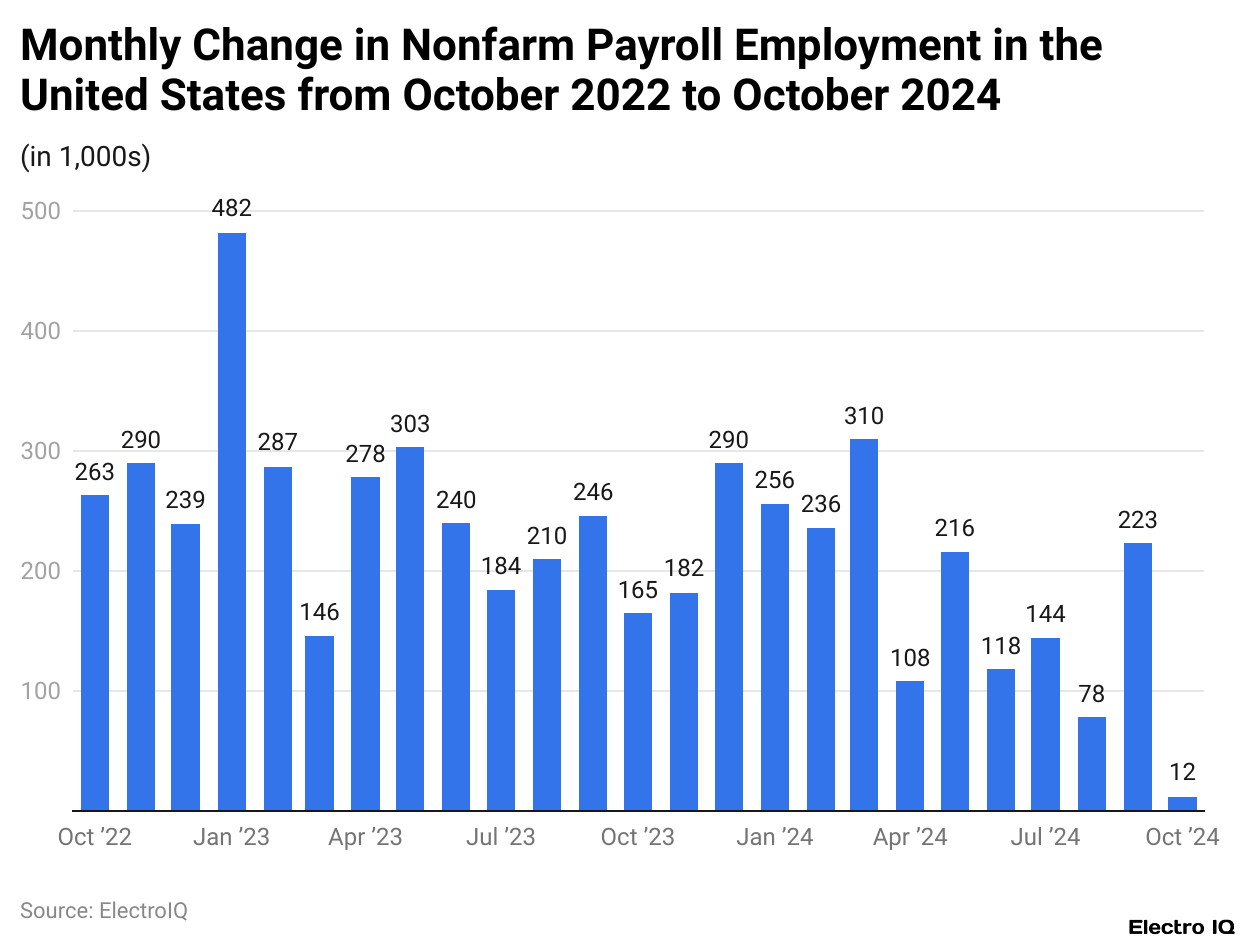
(Reference: statista.com)
- As per a Statista report, Payroll statistics show that the growth in total nonfarm payroll employment in the United States was about 12,000 in October 2024.
- This seasonally adjusted number provides a real picture of job growth that takes into account usual fluctuations throughout the year, including holidays and weather patterns.
- The figure is a result of the Current Employment Statistics (CES) program run by the Bureau of Labor Statistics (BLS).
- Around 140,000 businesses and government agencies are surveyed under this program every month, covering about 440,000 individual work sites.
- The goal is to collect detailed and reliable employment data across a variety of industries.
Number Of Employees Paid
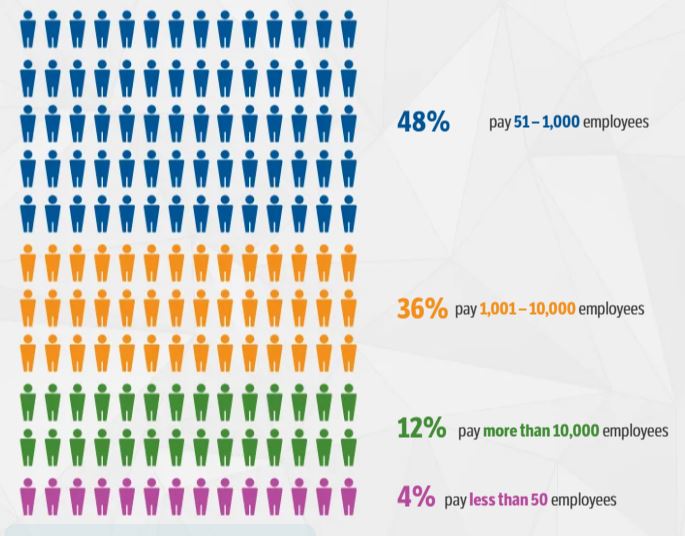
(Source: flippingbook.com)
- As per the Payslip survey report data, Payroll statistics show the company-wise distribution based on the number of employees paid via payroll systems.
- Almost half (48%) of the businesses have between 51 to 1,000 employees, making this range the largest. Another 36% of payroll operations are handled for organisations from 1,001 to 10,000 employees, revealing a majority of medium-sized to large enterprises.
- More than 10,000 employees are paid only by the remaining 12%, reflecting large-scale corporations with an immense workforce.
- On the other side, 4% of organisations process payroll for less than 50 employees, suggesting that small-sized businesses either outsource payroll processes or form a smaller %age of payroll software usage.
Payroll Frequency Statistics
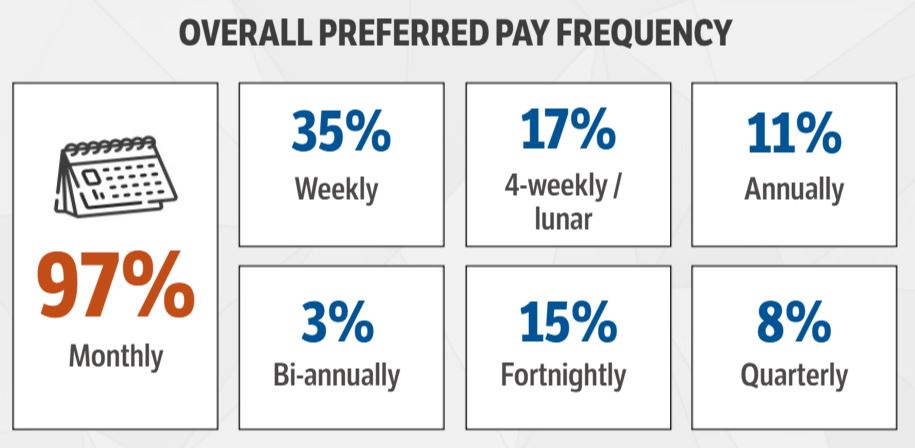
(Source: flippingbook.com)
- The data reveals the different payroll frequencies that organisations adopt.
- The bulk of companies, that is, 97 %, have payroll once a month, so by far, monthly payments are the most common.
- Weekly payroll is also somewhat common, with 35% of organisations using this method, probably from a preference in industries with hourly workers.
- A further 17% provide for 4-week or lunar cycle payments, while 15% have their employees paid every other week.
- There are less common payroll schedules with paydays occurring yearly (11%), quarterly (8%), or semi-annually (3%), perhaps having greater relevance under certain executive roles or contract basis arrangements.
- The whole range reflects the diversity among businesses in tailoring payroll timing to fit their operational needs and type of workers.
U.S. Monthly Change In Payroll Employment 2024, By Industry

(Reference: statista.com)
- The private education and health services sectors in the United States gained approximately 57,000 jobs in October 2024 compared to the month before, September 2024.
- This figure is a seasonally adjusted one, meaning it has been adjusted to account for usual fluctuations that occur across the months of the year.
- The BLS (Bureau of Labor Statistics) is said to collect such data from the Current Employment Statistics (CES) program.
Payroll Records Stored
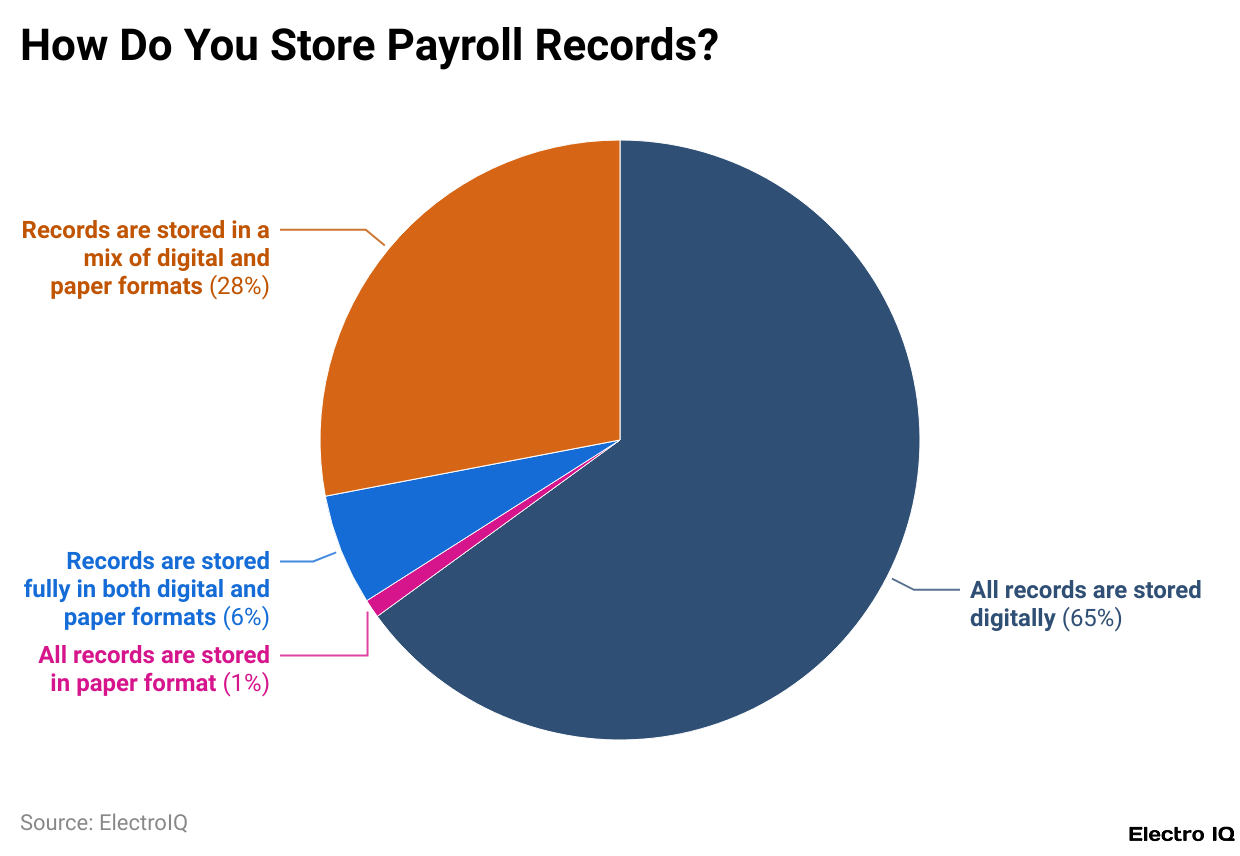
(Reference: flippingbook.com)
- The data shows that payroll records have been handled differently by organisations.
- A majority of 65% stores all their records digitally, reinforcing the modern trend toward the digital system, mainly due to efficiency issues and compliance.
- About 28% take a hybrid approach, partly digital and partly paper, thus implying some sort of transition in process where some processes have been digitised while others are still being carried out manually.
- Few would keep records in both digital and paper formats for about 6%, probably for some backup or compliance reasons.
- Just 1% continue to store all records on paper, indicating that fully manual systems have become practically extinct in today’s payroll management.
Payroll Error Statistics
- Payroll errors continue to be a great hindrance to businesses when it comes to employee dissatisfaction and financial penalties.
- An inability to pay an employee correctly or at the correct time is perhaps one of the most common payroll errors, and it includes underpayments, overpayments, or indeed full nonpayments; reported violations alone brought the IRS about US$2.8 billion in tax penalties about payrolls.
- These errors are not rare; 53% of companies have been penalised for payroll noncompliance in the last five years.
- Among the highlighted reasons behind the errors is manual interference with payroll processing.
- However, amidst these risks, only 8% of the companies affected contemplate equipping their payroll systems with AI within the next four years. Payroll errors can go on forever.
- Approximately 32% of global employees report that it takes at least two pay cycles to resolve an underpayment issue.
- There is another 22% with payroll errors occurring during pay cycles, such as tax recalculations and supplementary payments, which only makes the process more complicated.
- From a technology point of view, automation and AI are tools that are considered for adoption to simplify payroll.
- Nearly 77% of HR leaders have already embedded AI into payroll and HR functions such as benefits administration, staffing, and performance tracking.
- These improvements notwithstanding, the challenges are 85% of companies have reported having issues with their payroll technologies.
- They are found in missing features (39%), underutilization of the software’s full potential (37%), and essentially manual input requirements (34%).
- Integration of the systems is another big challenge. A significant 37% of the world’s companies are still working without complete integration across all HR systems.
- The top-ranked integration is with finance and accounting systems (41%), followed by benefit management and core HR systems (39% each), time and attendance tracking (38%), paid time off (PTO) management (37%), and Enterprise Resource Planning (ERP) systems (35%).
- Such integration gaps affect both the speed and accuracy of payroll operations, dictating the need for a well-aligned digital infrastructure.
Payroll Outsourcing
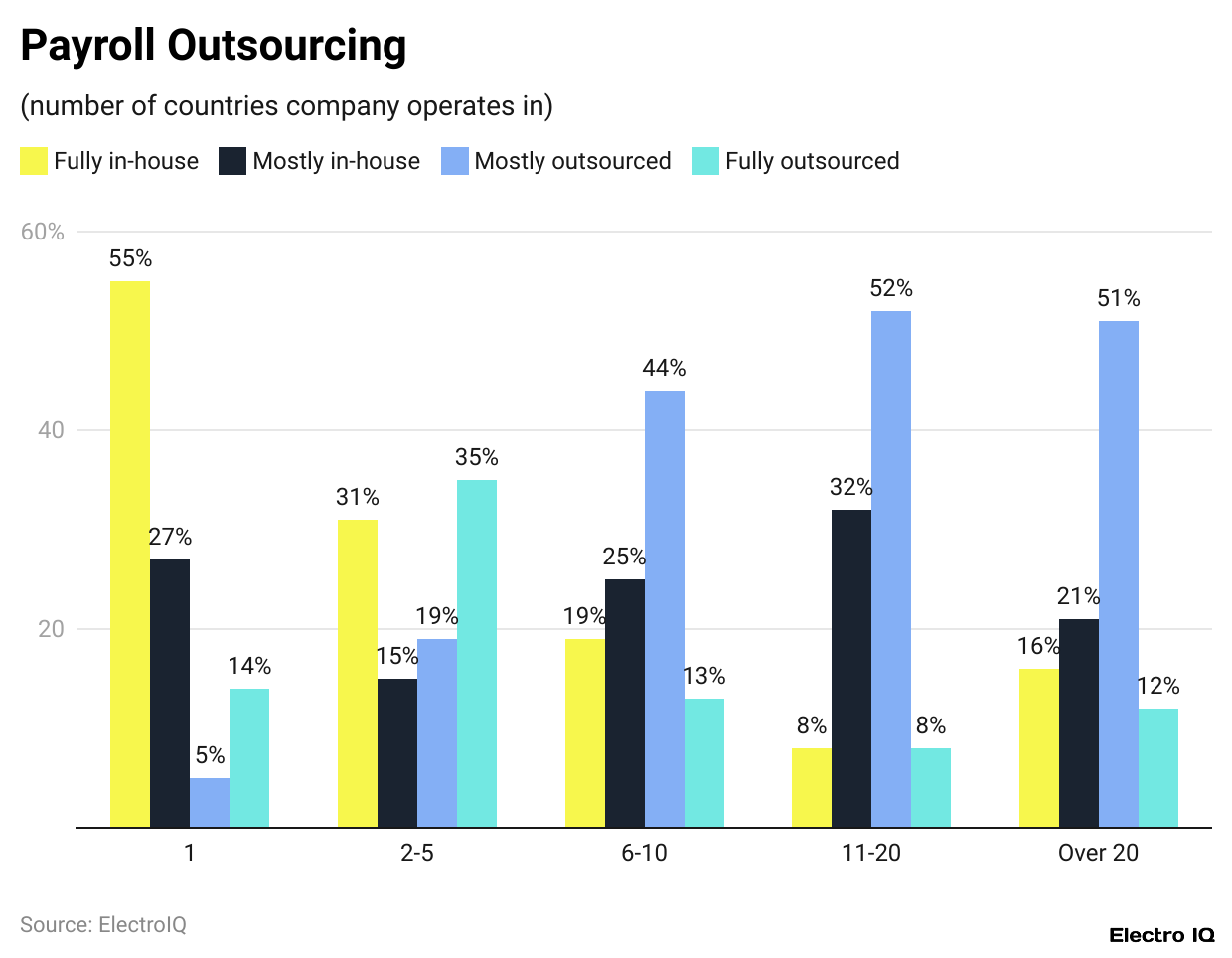
(Reference: selectsoftwarereviews.com)
- Alight’s Global Payroll Complexity Report 2024. Payroll statistics show that 55% of companies operating in just one country mostly want to keep payroll internal, but when company expansion goes into multiple countries, the trend shifts toward outsourcing.
- Unfortunately, for companies operating in 2 to 5 countries, the in-house management of payroll plummets to just 31%.
- It drops even further to 19% for companies operating in 6 to 10 countries, showing that global expansion usually comes with a bigger need for external payroll service providers.
- About 7 in 10 companies worldwide consider payroll outsourcing as a way of addressing talent issues.
- Many payroll leaders are now seeking to alleviate their teams from routine work through outsourcing so that their teams can have more time to focus on strategic initiatives and professional growth.
- According to an ADP report, 70% of payroll leaders are contemplating outsourcing some of their payroll functions to better support teams in different locations, while 69% are amenable to outsourcing a major part or even the totality of payroll activities on a global scale.
- Reluctant are companies despite the rise in outsourcing interest. Two-thirds of the non-outsourcing companies said that they are satisfied with their existing solutions, while another 12% said switching would be too much effort, and 10% said that they have never seen a convincing enough business case to warrant the change.
Payroll Automation Statistics
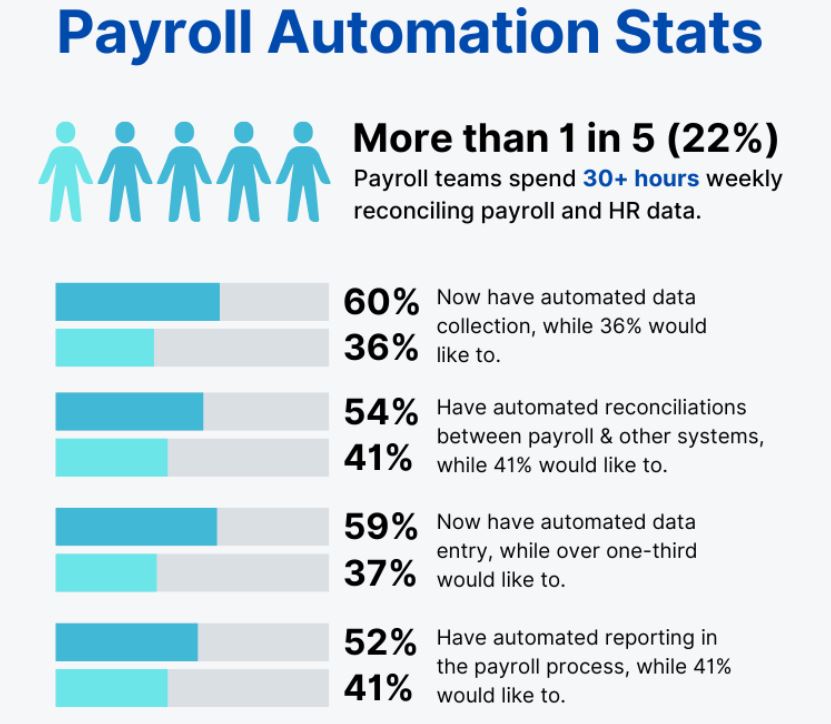
(Source: selectsoftwarereviews.com)
- Payroll automation has experienced noteworthy growth in recent years and has helped organisations decrease manual work and increase efficiency.
- In 2023, more than 22% of payroll teams reported that they spend more than 30 hours a week just reconciling payroll and HR data, according to ADP. A process that eats up so much time puts the spotlight on the need for a better system.
- In 2024, though, things have started to improve as many companies have embraced automation to liberate workers from these drudgeries.
- Presently, 60% of organisations have automated the process of collecting data, whereas another 36% are considering doing so.
- In terms of reconciling payroll with other business system functions, 54% have already automated the processes, 41% are working toward that goal, and another 59% say data entry automation is on the rise; they have either implemented it or are planning to follow suit.
- Reporting is another in the spotlight, with automated payroll reporting introduced by 52% of businesses and another 41% looking to implement it in the future.
- Another report from Eightfold corroborates this trend, stating that 77% of organisations now use some form of AI in their payroll processing and benefits administration.
- With growing dependence on automation and AI, it is clear that intelligent, efficient payroll management practices are needed.
Payroll Employee Retention Statistics
- Losing employee retention is now the end of the road due to the changing expectations about compensation and job benefits.
- On the other hand, salary remains a prime driver for talent, with more than 62.2% of candidates citing it as their main motivator.
- However, that is not a singular parameter: new challenges motivate about 24.6% of employees, whereas 20.8% of people want flexible work hours.
- 19.3% want more engaging work, and with another 19.3%, the matter is more money.
- Career advancement is the leading choice for 38.1% of workers when given reasons to just drift away from jobs; workplace flexibility stands second at 37.5%, and job security is rated third, with 32.1%.
- These insights mediate pay as just a piece of the larger jigsaw puzzle when it comes to retaining employees.
- About 57.4% of employers believe that increasing pay will most likely improve the employee experience. “…especially when considering the financial plight many workers face.”
- These financial issues are only five years old, a legacy from the Great Recession of the late 2000s.
- A whopping 78% of American workers had little to nothing in savings, spending most of their earnings in 2023.
- 56% said they could not cover a sudden US$1,000 expense with their savings, according to a telephone survey reported by Forbes.
- Now, concerning payroll, almost all (96%) workers are paid salaries via direct deposit, showing an inclined shift in favour of speedy and digital payments.
- One-fourth of employees stated that they will begin an active job search after the first payroll error is made.
- Half of the respondents said they would search for another job after the second instance.
- Though certainly, more than 65% of Americans consider a big paycheck a top consideration, almost 72% say that a slightly lower-paying job with better healthcare and medical benefits is a good deal.
Conclusion
Payroll statistics: The payroll scenario in 2024 reiterates the utmost importance of precise, efficient, and flexible systems. With the rise in wages, changes in workforce structures, and advancing technologies, organisations shall embrace modern-day payroll processes to stay compliant and keep workers happy.
Capitalising on digital-age solutions and embarking on dividing payroll challenges shall give businesses a solid foundation for a face-off with the very dynamic nature of the employment scenario.
Sources
FAQ.
Nonpayroll employees are the ones hired by the company but are not entered into the company payroll. This group cannot enjoy usual employee benefits or tax deductions; they are usually independent contractors, freelancers, or consultants who bill the company for services rendered, or are paid stipends.
In the entire United States, a pay frequency of every other week stands as the most popular. More than 50 % of all payroll runs take place this way. There exists much confusion about its use since biweekly can sometimes mean every two weeks or twice a week; the correct term should be every other week.
The number of pay periods per year varies based on an established payroll schedule: weekly, 52 pay periods; every other week (biweekly), 26 pay periods; twice a month (semi-monthly), 24 pay periods; monthly, 12 pay periods.
They say that around 70% of small and medium-sized U.S. companies use third-party service providers for payroll or software platforms such as ADP, QuickBooks Payroll, and Gusto to pay their respective workers and maintain compliance efficiently.
Depending on the size of the company, frequency of pay runs, and extra services such as tax filings or benefits administration, payroll processing might cost $150-$250 per employee per month.

Maitrayee Dey has a background in Electrical Engineering and has worked in various technical roles before transitioning to writing. Specializing in technology and Artificial Intelligence, she has served as an Academic Research Analyst and Freelance Writer, particularly focusing on education and healthcare in Australia. Maitrayee's lifelong passions for writing and painting led her to pursue a full-time writing career. She is also the creator of a cooking YouTube channel, where she shares her culinary adventures. At Smartphone Thoughts, Maitrayee brings her expertise in technology to provide in-depth smartphone reviews and app-related statistics, making complex topics easy to understand for all readers.

